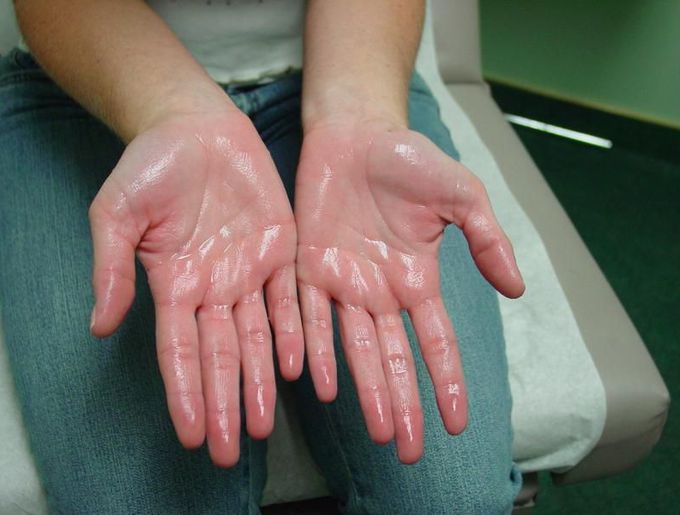


HYPERHIDROSIS
Hyperhidrosis, also known as polyhidrosis or sudorrhea, is a condition characterized by excessive sweating. The sweating can affect just one specific area or the whole body. Although not life-threatening, it can be uncomfortable and cause embarrassment and psychological trauma. The excessive sweating associated with hyperhidrosis is normally most active in the hands, feet, armpits, and the groin because of their relatively high concentration of sweat glands. Focal hyperhidrosis: When the excessive sweating is localized. For example, palmoplantar hyperhidrosis is excessive sweating of the palms and soles. Generalized hyperhidrosis: Excessive sweating affects the entire body. Hyperhidrosis may be present from birth or might develop later in life. However, most cases of excessive sweating tend to start during a person’s teenage years. The condition can be due to an underlying health condition, or have no apparent cause: Primary idiopathic hyperhidrosis: “Idiopathic” means “of unknown cause.” In the majority of cases, the hyperhidrosis is localized. Secondary hyperhidrosis: The person sweats too much because of an underlying health condition, such as obesity, gout, menopause, a tumor, mercury poisoning, diabetes mellitus, or hyperthyroidism (overactive thyroid gland). According to the International Hyperhidrosis Association, approximately 2.8 percent of Americans are affected by hyperhidrosis; that’s around 7.8 million people. For some, hyperhidrosis symptoms are so severe that it becomes embarrassing, causing discomfort and anxiety. The patient’s career choices, free time activities, personal relationships, self-image, and emotional well-being may be affected. Fortunately, there are several options which can treat symptoms effectively. The biggest challenge in treating hyperhidrosis is the significant number of people who do not seek medical advice, either due to embarrassment or because they do not know that effective treatment exists. Symptoms Hyperhidrosis is defined as sweating that disrupts normal activities. Episodes of excessive sweating occur at least once a week for no clear reason and have an effect on social life or daily activities. Signs and symptoms of hyperhidrosis may include: Clammy or wet palms of the hands Clammy or wet soles of the feet Frequent sweating Noticeable sweating that soaks through clothing People with hyperhidrosis might experience the following: Irritating and painful skin problems, such as fungal or bacterial infections Worrying about having stained clothing Reluctant to make physical contact Self-conscious Socially withdrawn, sometimes leading to depression Select employment where physical contact or human interaction is not a job requirement Spend a large amount of time each day dealing with sweat, such as changing clothes, wiping, placing napkins or pads under the arms, washing, wearing bulky, or dark clothes Worry more than other people about body odor Experts are not certain why, but excessive sweating during sleep is not common for people with primary hyperhidrosis (the type not linked to any underlying medical condition). Causes The causes of primary hyperhidrosis are not well-understood; on the other hand, secondary hyperhidrosis has a long list of known causes. Causes of primary hyperhidrosis People used to think that primary hyperhidrosis was linked to the patient’s mental and emotional state, that the condition was psychological and only affected stressed, anxious, or nervous individuals. However, recent research has demonstrated that individuals with primary hyperhidrosis are no more prone to feelings of anxiety, nervousness, or emotional stress than the rest of the population when exposed to the same triggers. In fact, it is the other way round – the emotional and mental feelings experienced by many patients with hyperhidrosis are because of the excessive sweating. Studies have also shown that certain genes play a role in hyperhidrosis, making it look more likely that it could be inherited. The majority of patients with primary hyperhidrosis have a sibling or parent with the condition. Causes of secondary hyperhidrosis Spinal cord injury Alcohol abuse Anxiety Diabetes Gout Heart disease Hyperthyroidism – an overactive thyroid gland Obesity Parkinson’s disease Pregnancy Respiratory failure Shingles Some cancers, such as Hodgkin’s disease Some infections – HIV, malaria, TB (tuberculosis) Some medications, including some antidepressants, anticholinesterases (for Alzheimer’s disease), pilocarpine (for glaucoma), propranolol (for high blood pressure) Substance abuse MedicalNewsToday uses cookies to improve your experience and to show you personalized ads. Privacy Policy. ACCEPTMore information What is hyperhidrosis?  Medically reviewed by University of Illinois — Written by Yvette Brazier on December 21, 2017 What is hyperhidrosis? Symptoms Causes Diagnosis Treatment Natural remedies Complications We include products we think are useful for our readers. If you buy through links on this page, we may earn a small commission. Here’s our process. Hyperhidrosis, also known as polyhidrosis or sudorrhea, is a condition characterized by excessive sweating. The sweating can affect just one specific area or the whole body. Although not life-threatening, it can be uncomfortable and cause embarrassment and psychological trauma. In this article, we will look at the causes, symptoms, diagnosis, and treatment of hyperhidrosis. Fast facts on hyperhidrosis Hyperhidrosis tends to begin during adolescence An estimated 7.8 million Americans have hyperhidrosis Most commonly, the feet, hands, face, and armpits are affected There are a number of remedies that can reduce symptoms What is hyperhidrosis? Share on PinterestHyperhidrosis can be psychologically damaging. The excessive sweating associated with hyperhidrosis is normally most active in the hands, feet, armpits, and the groin because of their relatively high concentration of sweat glands. Focal hyperhidrosis: When the excessive sweating is localized. For example, palmoplantar hyperhidrosis is excessive sweating of the palms and soles. Generalized hyperhidrosis: Excessive sweating affects the entire body. Hyperhidrosis may be present from birth or might develop later in life. However, most cases of excessive sweating tend to start during a person’s teenage years. The condition can be due to an underlying health condition, or have no apparent cause: Primary idiopathic hyperhidrosis: “Idiopathic” means “of unknown cause.” In the majority of cases, the hyperhidrosis is localized. Secondary hyperhidrosis: The person sweats too much because of an underlying health condition, such as obesity, gout, menopause, a tumor, mercury poisoning, diabetes mellitus, or hyperthyroidism (overactive thyroid gland). According to the International Hyperhidrosis Association, approximately 2.8 percent of Americans are affected by hyperhidrosis; that’s around 7.8 million people. For some, hyperhidrosis symptoms are so severe that it becomes embarrassing, causing discomfort and anxiety. The patient’s career choices, free time activities, personal relationships, self-image, and emotional well-being may be affected. Fortunately, there are several options which can treat symptoms effectively. The biggest challenge in treating hyperhidrosis is the significant number of people who do not seek medical advice, either due to embarrassment or because they do not know that effective treatment exists. Symptoms Hyperhidrosis is defined as sweating that disrupts normal activities. Episodes of excessive sweating occur at least once a week for no clear reason and have an effect on social life or daily activities. Share on PinterestSimple lifestyle changes can sometimes ease hyperhidrosis’ symptoms. Signs and symptoms of hyperhidrosis may include: Clammy or wet palms of the hands Clammy or wet soles of the feet Frequent sweating Noticeable sweating that soaks through clothing People with hyperhidrosis might experience the following: Irritating and painful skin problems, such as fungal or bacterial infections Worrying about having stained clothing Reluctant to make physical contact Self-conscious Socially withdrawn, sometimes leading to depression Select employment where physical contact or human interaction is not a job requirement Spend a large amount of time each day dealing with sweat, such as changing clothes, wiping, placing napkins or pads under the arms, washing, wearing bulky, or dark clothes Worry more than other people about body odor Experts are not certain why, but excessive sweating during sleep is not common for people with primary hyperhidrosis (the type not linked to any underlying medical condition). MEDICAL NEWS TODAY RESOURCE Virus spread and climate change: A West Nile virus case study COVID-19 has made the entire world painfully aware of the terrible power that viruses can wield. Learn how climate change impacts the spread of other viruses, such as West Nile virus, in our feature article. GO NOW Causes The causes of primary hyperhidrosis are not well-understood; on the other hand, secondary hyperhidrosis has a long list of known causes. Causes of primary hyperhidrosis Share on PinterestPrimary hyperhidrosis appears to have a genetic component. People used to think that primary hyperhidrosis was linked to the patient’s mental and emotional state, that the condition was psychological and only affected stressed, anxious, or nervous individuals. However, recent research has demonstrated that individuals with primary hyperhidrosis are no more prone to feelings of anxiety, nervousness, or emotional stress than the rest of the population when exposed to the same triggers. In fact, it is the other way round – the emotional and mental feelings experienced by many patients with hyperhidrosis are because of the excessive sweating. Studies have also shown that certain genes play a role in hyperhidrosis, making it look more likely that it could be inherited. The majority of patients with primary hyperhidrosis have a sibling or parent with the condition. Causes of secondary hyperhidrosis Spinal cord injury Alcohol abuse Anxiety Diabetes Gout Heart disease Hyperthyroidism – an overactive thyroid gland Obesity Parkinson’s disease Pregnancy Respiratory failure Shingles Some cancers, such as Hodgkin’s disease Some infections – HIV, malaria, TB (tuberculosis) Some medications, including some antidepressants, anticholinesterases (for Alzheimer’s disease), pilocarpine (for glaucoma), propranolol (for high blood pressure) Substance abuse Diagnosis Initially, a doctor may try to rule out any underlying conditions, such as an overactive thyroid (hyperthyroidism) or low blood sugar (hypoglycemia) by ordering blood and urine tests. Patients will be asked about the patterns of their sweating – which parts of the body are affected, how often sweating episodes occur, and whether sweating occurs during sleep. The patient may be asked a series of questions, or have to fill in a questionnaire about the impact of excessive sweating; questions may include: Do you carry anything around to deal with episodes of excessive sweating, such as napkins, antiperspirants, towels, or pads? Does hyperhidrosis affect your behavior or mental state when you are in public? Has hyperhidrosis had any effect on your employment? Have you ever lost a friend due to hyperhidrosis? How often do you change your clothing? How often do you wash or have a shower/bath? How often do you think about excessive sweating? Thermoregulatory sweat test: a powder which is sensitive to moisture is applied to the skin. When excessive sweating occurs at room temperature, the powder changes color. The patient is then exposed to high heat and humidity in a sweat cabinet, which triggers sweating throughout the whole body. When exposed to heat, people who do not have hyperhidrosis tend not to sweat excessively in the palms of their hands, but patients with hyperhidrosis do. This test also helps the doctor determine the severity of the condition. Natural remedies Some alterations in daily activity and lifestyle may help improve symptoms: Antiperspirants – deodorants do not stop sweating, but antiperspirants sprays do. Some prescription antiperspirants include aluminum chloride, which plugs the sweat glands. Armpit shields – pads worn in the armpit to protect a garment from perspiration. Clothing – certain synthetic fibers, such as nylon, may worsen symptoms. Loose clothing is better. Shoes – synthetic materials are more likely to worsen symptoms. Natural materials, such as leather, are recommended. Socks – some socks are better at absorbing moisture, such as thick, soft ones made of natural fibers. If these measures are not effective, medical treatment may help. Treatment A doctor may refer the person to a skin specialist, or dermatologist. They may recommend: Iontophoresis – the hands and feet are submerged in a bowl of water. A painless electric current is passed through the water. Most patients need two to four 20-30 minute treatments. Botulinum toxin (Botox injections) – Botox injections block the nerves that trigger the sweat glands. Patients with hyperhidrosis may need several injections for effective results. Anticholinergic drugs – these medications inhibit the transmission of parasympathetic nerve impulses. Patients generally notice an improvement in symptoms within about 2 weeks. ETS (Endoscopic thoracic sympathectomy) – this surgical intervention is only recommended in severe cases which have not responded to other treatments. The nerves that carry messages to the sweat glands are cut. ETS may be used to treat hyperhidrosis of the face, hands or armpits. ETS is not recommended for treating hyperhidrosis of the feet because of the risk of permanent sexual dysfunction. Complications If hyperhidrosis is not treated, it can lead to complications. Nail infections: Especially toenail infections. Warts: Skin growths caused by the HPV (human papillomavirus). Bacterial infections: Especially around hair follicles and between the toes. Heat rash (prickly heat, miliaria): An itchy, red skin rash that often causes a stinging or prickling sensation. Heat rash develops when sweat ducts become blocked and perspiration is trapped under the skin. Psychological impact: Excessive sweating can affect the patient’s self-confidence, job, and relationships. Some individuals may become anxious, emotionally stressed, socially withdrawn, and even depressed. On average, a person with hyperhidrosis seeks medical help after living with the condition for 9 years. It is important to spread the word that the symptoms of excessive sweating can be effectively treated.
I’ve been living with Parkinson’s disease for quite some time, and for years, I struggled to find lasting relief. While medications offered some temporary help, the symptoms always returned and often worsened.Out of a mix of hope and hesitation, I decided to try an herbal treatment program from NaturePath Herbal Clinic. I’ll admit, I was skeptical at first. But around the fourth month, I began to notice real, steady progress.my tremors became less frequent the stiffness in my body eased My balance and coordination gradually improved It wasn’t an overnight transformation, but it was consistent and life changing. For the first time in years, I feel more in control of my body. I can move with greater freedom, sleep more peacefully, and enjoy daily activities without the constant discomfort I once accepted as normal.The improvement I’ve experienced physically, emotionally, and mentally has been nothing short of upliftings.If you're exploring natural options for managing Parkinson’s, I wholeheartedly recommend looking into NaturePath Herbal Clinic. Their approach has made a real difference in my life, and I’m truly grateful I gave it a chance. www.naturepathherbalclinic.com info@naturepathherbalclinic.com



